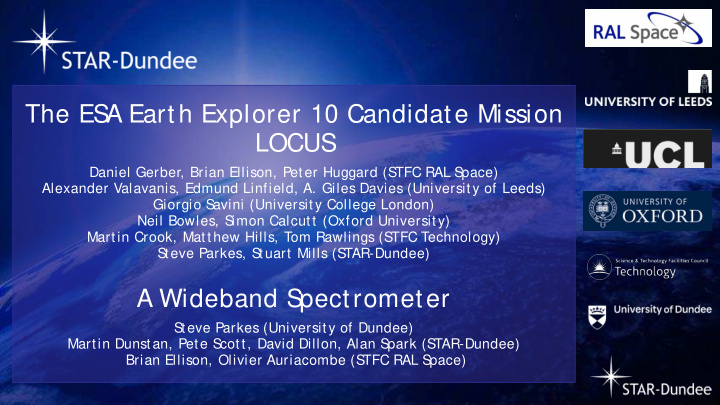



The ES A Earth Explorer 10 Candidate Mission LOCUS Daniel Gerber, Brian Ellison, Peter Huggard (S TFC RAL S pace) Alexander Valavanis, Edmund Linfield, A. Giles Davies (University of Leeds) Giorgio S avini (University College London) Neil Bowles, S imon Calcutt (Oxford University) Martin Crook, Matthew Hills, Tom Rawlings (S TFC Technology) S teve Parkes, S tuart Mills (S TAR-Dundee) A Wideband S pectrometer S teve Parkes (University of Dundee) Martin Dunstan, Pete S cott, David Dillon, Alan S park (S TAR-Dundee) Brian Ellison, Olivier Auriacombe (S TFC RAL S pace)
• Small satellite mission • Study composition and thermal structure of Mesosphere – Lower Thermosphere (50km to 150km) • Least well known region of our atmosphere! • Gather missing data to improve climate and weather models LOCUS EE-10 Concept on AstroBus platform
• Two instruments: • THz heterodyne radiometer Composition of key trace gases • Infrared detectors Heat fluxes • Climate Science: Understand if – and by how much – MLT cooling is linked to climate change [Solomon et al. 2018] • Space Weather: Understand the There is a clear cooling trend in the MLT – much stronger than the Tropospheric warming – but we have no idea impact of charged particles on the how much of it is from an increase in greenhouse gases upper and middle atmosphere
• LOCUS (Supra-) THz instrument only becoming viable now through innovative technologies that bridge the “THz-Gap”: Quantum Cascade Laser devices Miniature space Improved Schottky as a high-power source to pump coolers to provide diode manufacturing heterodyne Schottky mixers for THz frequencies QCL cooling (~70K)
Wideband Spectrometer WBS-V • WBS V is a prototype device with a clear path to space flight • High-performance FFT based spectrometer • Designed, implemented and tested • Using radiation tolerant parts • Or commercial equivalents of radiation tolerant parts • 2 GHz bandwidth and 2.4 MHz FFT bins giving 10 MHz resolution • A 1024-point FFT implemented in the Microsemi RTG4 FPGA • Processing power is in the region of 100 GOPS • Enabling 1024-point FFT to operate at 2.4 Gsamples/s • With I and Q inputs • STAR-Dundee is now working on an 8 GHz bandwidth spectrometer
WBS-V In Action Background Target (77K) via plane Mylar window Vacuum Chamber mirror Local Oscillator IQ Down Conversion Front-End WBS Vacuum Pump Movable flat mirror Cold Target Receiver front-end
WBS-V In Action
Recommend
More recommend